2006 CHEVROLET SILVERADO wheel alignment
[x] Cancel search: wheel alignmentPage 406 of 594
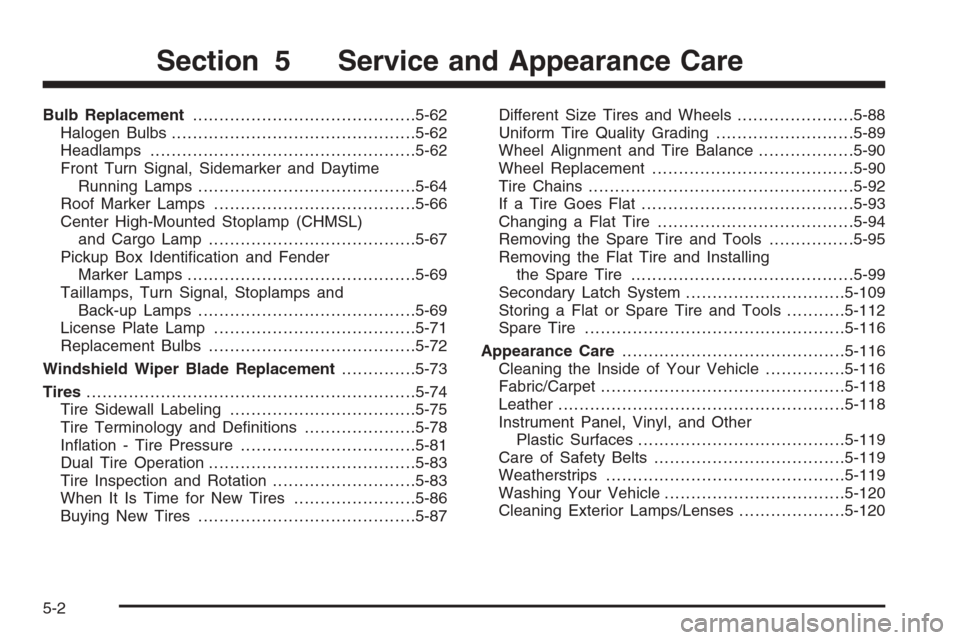
Bulb Replacement..........................................5-62
Halogen Bulbs..............................................5-62
Headlamps..................................................5-62
Front Turn Signal, Sidemarker and Daytime
Running Lamps.........................................5-64
Roof Marker Lamps......................................5-66
Center High-Mounted Stoplamp (CHMSL)
and Cargo Lamp.......................................5-67
Pickup Box Identi�cation and Fender
Marker Lamps...........................................5-69
Taillamps, Turn Signal, Stoplamps and
Back-up Lamps.........................................5-69
License Plate Lamp......................................5-71
Replacement Bulbs.......................................5-72
Windshield Wiper Blade Replacement..............5-73
Tires..............................................................5-74
Tire Sidewall Labeling...................................5-75
Tire Terminology and De�nitions.....................5-78
In�ation - Tire Pressure.................................5-81
Dual Tire Operation.......................................5-83
Tire Inspection and Rotation...........................5-83
When It Is Time for New Tires.......................5-86
Buying New Tires.........................................5-87Different Size Tires and Wheels......................5-88
Uniform Tire Quality Grading..........................5-89
Wheel Alignment and Tire Balance..................5-90
Wheel Replacement......................................5-90
Tire Chains..................................................5-92
If a Tire Goes Flat........................................5-93
Changing a Flat Tire.....................................5-94
Removing the Spare Tire and Tools................5-95
Removing the Flat Tire and Installing
the Spare Tire..........................................5-99
Secondary Latch System..............................5-109
Storing a Flat or Spare Tire and Tools...........5-112
Spare Tire.................................................5-116
Appearance Care..........................................5-116
Cleaning the Inside of Your Vehicle...............5-116
Fabric/Carpet..............................................5-118
Leather......................................................5-118
Instrument Panel, Vinyl, and Other
Plastic Surfaces.......................................5-119
Care of Safety Belts....................................5-119
Weatherstrips.............................................5-119
Washing Your Vehicle..................................5-120
Cleaning Exterior Lamps/Lenses....................5-120
Section 5 Service and Appearance Care
5-2
Page 487 of 594
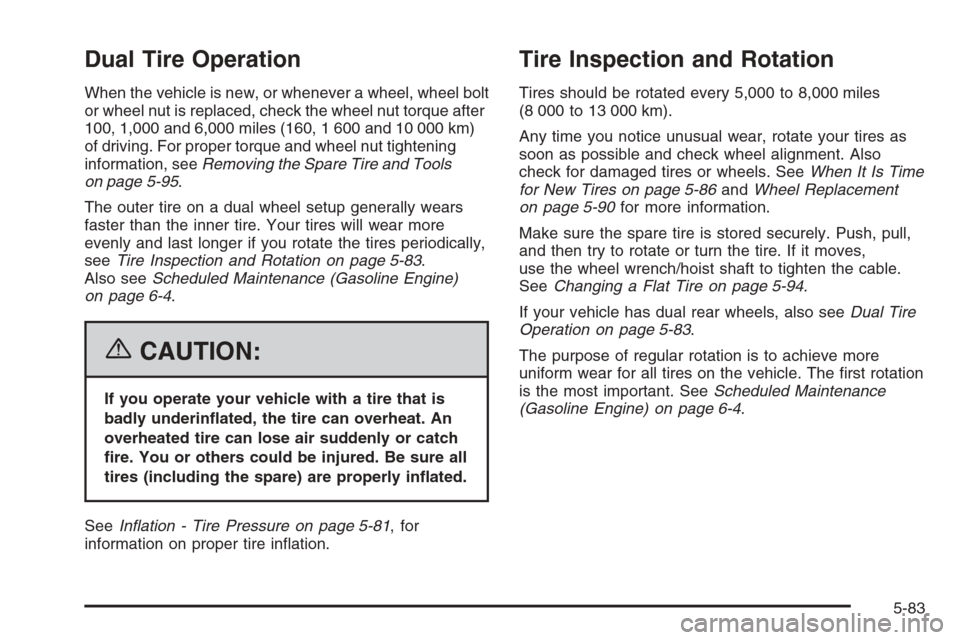
Dual Tire Operation
When the vehicle is new, or whenever a wheel, wheel bolt
or wheel nut is replaced, check the wheel nut torque after
100, 1,000 and 6,000 miles (160, 1 600 and 10 000 km)
of driving. For proper torque and wheel nut tightening
information, seeRemoving the Spare Tire and Tools
on page 5-95.
The outer tire on a dual wheel setup generally wears
faster than the inner tire. Your tires will wear more
evenly and last longer if you rotate the tires periodically,
seeTire Inspection and Rotation on page 5-83.
Also seeScheduled Maintenance (Gasoline Engine)
on page 6-4.
{CAUTION:
If you operate your vehicle with a tire that is
badly underin�ated, the tire can overheat. An
overheated tire can lose air suddenly or catch
�re. You or others could be injured. Be sure all
tires (including the spare) are properly in�ated.
SeeIn�ation - Tire Pressure on page 5-81, for
information on proper tire in�ation.
Tire Inspection and Rotation
Tires should be rotated every 5,000 to 8,000 miles
(8 000 to 13 000 km).
Any time you notice unusual wear, rotate your tires as
soon as possible and check wheel alignment. Also
check for damaged tires or wheels. SeeWhen It Is Time
for New Tires on page 5-86andWheel Replacement
on page 5-90for more information.
Make sure the spare tire is stored securely. Push, pull,
and then try to rotate or turn the tire. If it moves,
use the wheel wrench/hoist shaft to tighten the cable.
SeeChanging a Flat Tire on page 5-94.
If your vehicle has dual rear wheels, also seeDual Tire
Operation on page 5-83.
The purpose of regular rotation is to achieve more
uniform wear for all tires on the vehicle. The �rst rotation
is the most important. SeeScheduled Maintenance
(Gasoline Engine) on page 6-4.
5-83
Page 494 of 594
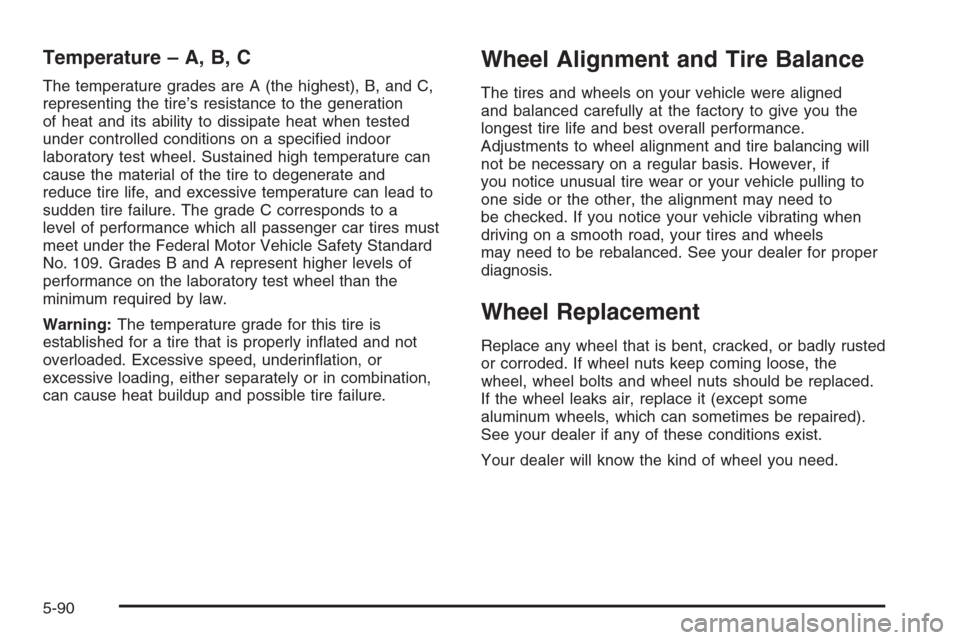
Temperature – A, B, C
The temperature grades are A (the highest), B, and C,
representing the tire’s resistance to the generation
of heat and its ability to dissipate heat when tested
under controlled conditions on a speci�ed indoor
laboratory test wheel. Sustained high temperature can
cause the material of the tire to degenerate and
reduce tire life, and excessive temperature can lead to
sudden tire failure. The grade C corresponds to a
level of performance which all passenger car tires must
meet under the Federal Motor Vehicle Safety Standard
No. 109. Grades B and A represent higher levels of
performance on the laboratory test wheel than the
minimum required by law.
Warning:The temperature grade for this tire is
established for a tire that is properly in�ated and not
overloaded. Excessive speed, underin�ation, or
excessive loading, either separately or in combination,
can cause heat buildup and possible tire failure.
Wheel Alignment and Tire Balance
The tires and wheels on your vehicle were aligned
and balanced carefully at the factory to give you the
longest tire life and best overall performance.
Adjustments to wheel alignment and tire balancing will
not be necessary on a regular basis. However, if
you notice unusual tire wear or your vehicle pulling to
one side or the other, the alignment may need to
be checked. If you notice your vehicle vibrating when
driving on a smooth road, your tires and wheels
may need to be rebalanced. See your dealer for proper
diagnosis.
Wheel Replacement
Replace any wheel that is bent, cracked, or badly rusted
or corroded. If wheel nuts keep coming loose, the
wheel, wheel bolts and wheel nuts should be replaced.
If the wheel leaks air, replace it (except some
aluminum wheels, which can sometimes be repaired).
See your dealer if any of these conditions exist.
Your dealer will know the kind of wheel you need.
5-90
Page 592 of 594
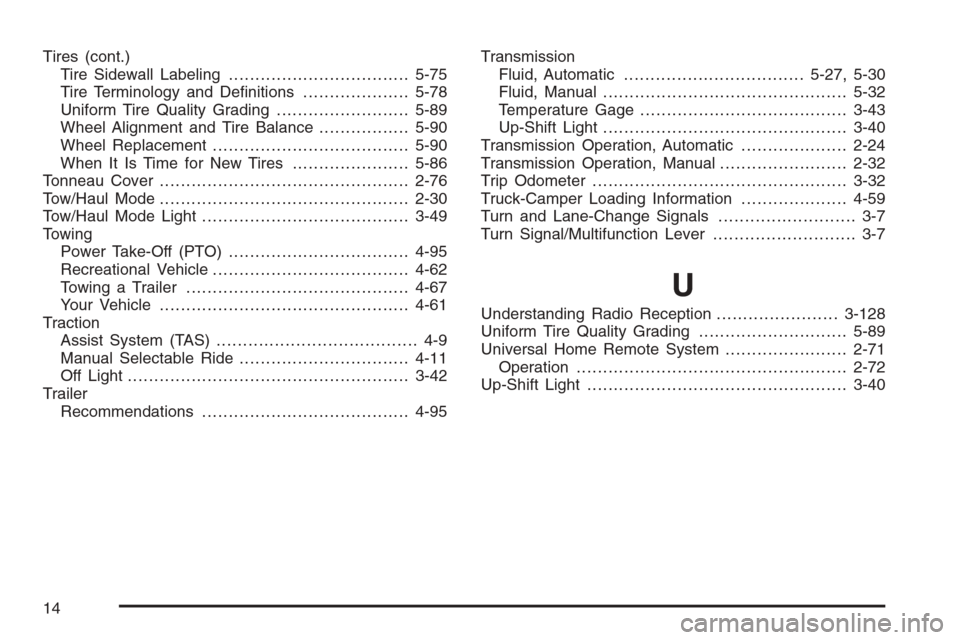
Tires (cont.)
Tire Sidewall Labeling..................................5-75
Tire Terminology and De�nitions....................5-78
Uniform Tire Quality Grading.........................5-89
Wheel Alignment and Tire Balance.................5-90
Wheel Replacement.....................................5-90
When It Is Time for New Tires......................5-86
Tonneau Cover...............................................2-76
Tow/Haul Mode ...............................................2-30
Tow/Haul Mode Light.......................................3-49
Towing
Power Take-Off (PTO)..................................4-95
Recreational Vehicle.....................................4-62
Towing a Trailer..........................................4-67
Your Vehicle...............................................4-61
Traction
Assist System (TAS)...................................... 4-9
Manual Selectable Ride................................4-11
Off Light.....................................................3-42
Trailer
Recommendations.......................................4-95Transmission
Fluid, Automatic..................................5-27, 5-30
Fluid, Manual..............................................5-32
Temperature Gage.......................................3-43
Up-Shift Light..............................................3-40
Transmission Operation, Automatic....................2-24
Transmission Operation, Manual........................2-32
Trip Odometer................................................3-32
Truck-Camper Loading Information....................4-59
Turn and Lane-Change Signals.......................... 3-7
Turn Signal/Multifunction Lever........................... 3-7
U
Understanding Radio Reception.......................3-128
Uniform Tire Quality Grading............................5-89
Universal Home Remote System.......................2-71
Operation...................................................2-72
Up-Shift Light.................................................3-40
14
Page 593 of 594
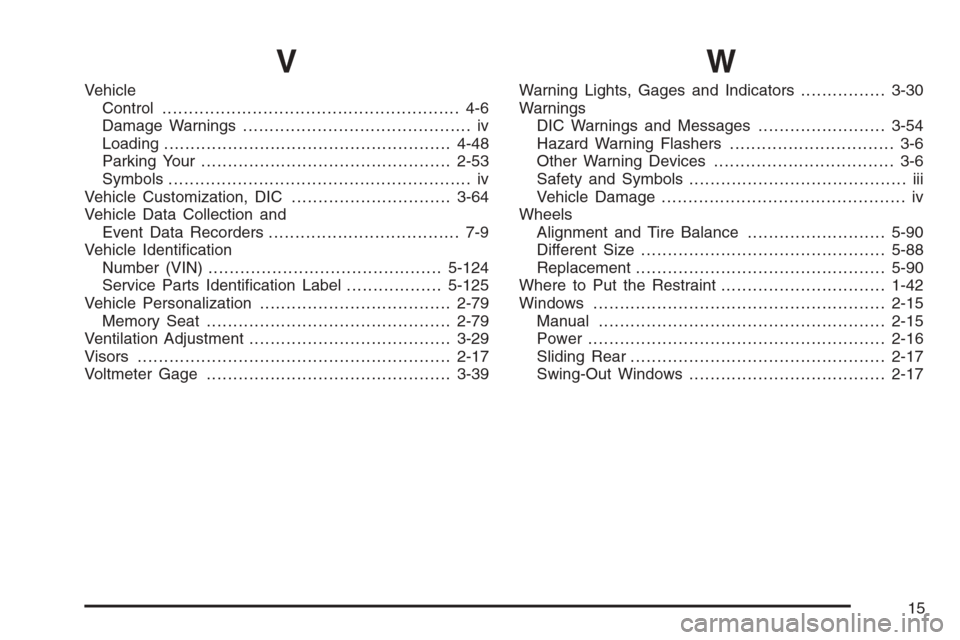
V
Vehicle
Control........................................................ 4-6
Damage Warnings........................................... iv
Loading......................................................4-48
Parking Your...............................................2-53
Symbols......................................................... iv
Vehicle Customization, DIC..............................3-64
Vehicle Data Collection and
Event Data Recorders.................................... 7-9
Vehicle Identi�cation
Number (VIN)............................................5-124
Service Parts Identi�cation Label..................5-125
Vehicle Personalization....................................2-79
Memory Seat..............................................2-79
Ventilation Adjustment......................................3-29
Visors...........................................................2-17
Voltmeter Gage..............................................3-39
W
Warning Lights, Gages and Indicators................3-30
Warnings
DIC Warnings and Messages........................3-54
Hazard Warning Flashers............................... 3-6
Other Warning Devices.................................. 3-6
Safety and Symbols......................................... iii
Vehicle Damage.............................................. iv
Wheels
Alignment and Tire Balance..........................5-90
Different Size..............................................5-88
Replacement...............................................5-90
Where to Put the Restraint...............................1-42
Windows.......................................................2-15
Manual......................................................2-15
Power ........................................................2-16
Sliding Rear................................................2-17
Swing-Out Windows.....................................2-17
15